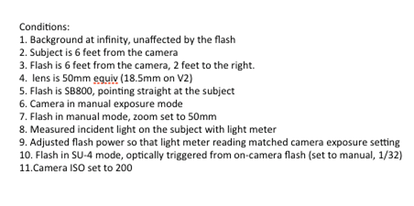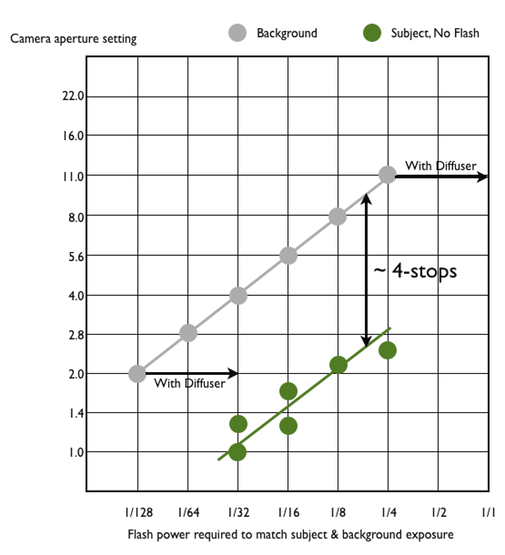Small cameras have small flashes which are notoriously useless for any practical application. Going in, my expectations are that I'll conclude that flash photography is an area where DSLR's are required.
The Nikon 1 series have a confusing array of flash options:
1. On-camera flash.
Guide number - 5/15 (m/ft ISO 100, 20degC/68degF) Approx.
At ISO 160, Guide Number is approx. (6.3/20.7)
2. SBN-5. Small external flash, mounted on hot shoe, powered by the camera
Guide number - 8.5m/27.9ft (at ISO 100, 20degC/68DegF) to 12m/39.4ft. (at ISO 200, 20degC/68degF)
Effective flash range - 2 to 66 ft. (0.6 to 20 m) (varies with ISO sensitivity, bounce angle, and aperture)
3. SBN-7. Small external flash, mounted on the hot shoe, powered with AAA batteries
Guide number - 18 m/59 ft. (at ISO 100) with wide panel 10 m/33 ft. (at ISO 100)
Effective flash range - 2 to 66 ft. (0.6 to 20 m) (varies with ISO sensitivity, bounce angle, and aperture)
For comparison, the specs on the SB900/910, the top of the line speedlights for DSLR's:
Guide number - 34 m/111.5 ft. (at ISO 100, 35mm zoom head position, in FX format, standard illumination pattern, 20°C/68°F) to 48 m/157.5 ft. (at ISO 200, 35mm zoom head position, in FX format, standard illumination pattern, 20°C/68°F)
Nikon SB400
Guide Number - 69ft (at ISO 100)
LumoPro LP180
Guide Number - 110ft (at ISO 100, 105mm zoom head position)
Metz 28 CS2
Guide Number - 72ft (at ISO 100, 35mm zoom head position)
Practical Considerations.
In looking at the lighting potential with small cameras I went straight for the external flash solutions since creating nicely lit pictures with on-camera flash is challenging, even for DSLR's. I focussed on the Nikin 1 V2, in particular for a number of reasons:
1. Most Nikon Speedlights (my favorite is the SB-800) have an "SU-4" mode which means that it can be optically triggered from another flash.
2. The Nikon V2 has an on-board flash that can be set, manually, to low power but sufficient to trigger an external flash
3. If this is not sufficient, the SBN-5 has a swivel head that can point more directly at the external flash.
4. I already have a number of Nikon Speedlights.
There are, however, a number of major limitations:
1. The camera and flash need to be operated in manual mode - no auto here.
2. The flash is at least twice as big as the camera making it cumbersome to use
3. Fastest shutter speed is 1/250th sec with flash enabled (this is not different from most DSLR's)
4. Apertures smaller than f/8 tend to introduce significant diffraction.
5. Limitations in #3 & #4 limit the ability of the camera in high brightness, high contrast situations.
Given these pros and cons, I set about looking at various lighting situations and how to deal with them using this small camera - external flash combination.
Essentially, lighting can be categorized intot he following:
1. Contrast enhancement
2. Contrast reduction
3. Complete lighting
4. Artistic effects
Here are examples of each.
1. Contrast enhancement is when you have a low contrast scene and you want the main subject to "pop". You do this by slightly under-exposing the ambient background and then correctly exposing the main subject. Here is an example:

This was a foggy morning at the beach. A small amount of flash lit up the Lifeguard Station. I underexposed the background ~1 stop to create some contrast.
Nikon V2, 1/250sec, f/6.3, ISO 160. SB-800@ 1/4 (I think) at arm's length to the left
Here's an example without flash:

2. Contrast Reduction
Contrast reduction is where you use flash to flatten out a high contrast scene. One example is where you have a bright background but the main subject is in the shade and you want to lighten them up. Typically, the camera is exposed for the background and the flash power is set to expose the subject. Here's an example:
No flash. Nikon V2, 1/125, f/5.6, ISO 200

With Flash, same camera exposure,SB-800 @ 1/16 (sorry, not smiling) on tripod, 6ft from subject, 2ft to the right

With this example, I set out to measure the amount of exposure required at various light levels in order to see if there was a rule-of-thumb I could develop which would allow me to get the exposure and flash power approximately correct for various light and contrast levels without needing an exposure meter.. The example above was shot at various light levels as the sun set (behind the camera). and allowed me to see how things scaled with the amount of abackground light.
Here is a graph of what I measured:



1. As the sun set, I opened up the aperture (and slowed the shutter speed) to maintain correct exposure for the background (from f/11 -> f/2.0) - the gray line
2. Without flash, the exposure required to properly expose the subject (me) was approx. 4-stops greater and this tracked as the ambient light decreased. (not entirely intuitive) - the green line
3. As the light decreased, the amount of flash required to light the subject also decreased - the horizontal axis
4. The amount of flash required to illuminate the subject was independent of the shutter speed of the camera (as expected)
5. When I added a diffuser, with the flash head pointing directly at the subject, I needed 2-stops more flash power (4X) to illuminate the subject.
From this data it should be possible to extrapolate for different light levels, different contrasts and different distances to the subject.
For example, if the contrast difference were 3 stops versus 4, then the assumption would be we would need 1/2 the flash power. if the distance of the flash were 12ft inststead of 6ft, then we would need 4X the flash power (power needed increases by the square of the distance).

Here's another example of contrast reduction where the camera is exposed for the exterior and the flash is set to illuminate the interior.